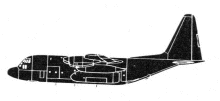Incident Overview

Description
A Lockheed C-130 Hercules firefighting aircraft impacted terrain and burst into flames near Cooma, north-east of the Snowy Mountains in Australia. All three crew members died in the accident. The aircraft, contracted to the New South Wales Rural Fire Service, departed Richmond RAAF Base, Australia at 12:05 local time. The crew had been tasked with a fire retardant drop over the Adaminaby Complex bush fire. After approaching the Adaminaby complex fire, the drop was unable to be completed and the aircraft was diverted to a secondary tasking, to drop retardant on the Good Good fire. Witnesses reported seeing the aircraft complete a number of circuits, prior to completing the retardant drop. The drop was conducted on a heading of about 190ø, at about 200 ft above ground level, with a drop time of approximately 2 seconds. The crew released about 1,200 US gallons (4,500 L) of fire retardant during the drop. Witness videos taken of the aircraft leading up to the accident showed a number of passes conducted at varying heights prior to the retardant drop. Following the retardant drop, the aircraft was observed to bank left, before becoming obscured by smoke after about 5 seconds. A further 15 seconds after this, the aircraft was seen flying at a very low height above the ground, in a left wing down attitude. Shortly after, at about 13:16, the aircraft collided with terrain and a post-impact fuel-fed fire ensued. The three crew were fatally injured and the aircraft was destroyed. Contributing factors: – Hazardous weather conditions were forecast and present at the drop site near Peak View, which included strong gusting winds and mountain wave activity, producing turbulence. These conditions were likely exacerbated by the fire and local terrain. – The Rural Fire Service continued the B134 tasking to Adaminaby when they learned that no other aircraft would continue to operate due to the environmental conditions. In addition, they relied on the pilot in command to assess the appropriateness of the tasking to Adaminaby without providing them all the available information to make an informed decision on flight safety. – The pilot in command of B134 accepted the Adaminaby fire-ground tasking, which was in an area of forecast mountain wave activity and severe turbulence. After assessing the conditions as unsuitable, the crew accepted an alternate tasking to continue to the Good Good (Peak View) fire-ground, which was subject to the same weather conditions. The acceptance of these taskings were consistent with company practices. – Following the partial retardant drop and left turn, the aircraft was very likely subjected to hazardous environmental conditions including low-level windshear and an increased tailwind component, which degraded the aircrafts climb performance. – While at a low height and airspeed, it was likely the aircraft aerodynamically stalled, leading to a collision with terrain. – Coulson Aviation’s safety risk management processes did not adequately manage the risks associated with large air tanker operations. There were no operational risk assessments conducted or a risk register maintained. Further, as safety incident reports submitted were mainly related to maintenance issues, operational risks were less likely to be considered or monitored. Overall, this limited their ability to identify and implement mitigations to manage the risks associated with their aerial firefighting operations. (Safety issue) – Coulson Aviation did not provide a pre-flight risk assessment for their firefighting large air tanker crews. This would provide predefined criteria to ensure consistent and objective decision-making with accepting or rejecting tasks, including factors relating to crew, environment, aircraft and external pressures. (Safety issue) – The New South Wales Rural Fire Service had limited large air tanker policies and procedures for aerial supervision requirements and no procedures for deployment without aerial supervision. (Safety issue) – The New South Wales Rural Fire Service did not have a policy or procedures in place to manage task rejections, nor to communicate this information internally or to other pilots working in the same area of operation. (Safety issue)
Source of Information
https://www.atsb.gov.au/publications/investigation_reports/2020/aair/ao-2020-007/, https://flightaware.com/live/flight/N134CG/history/20200123/0115Z/YSRI/YSRI, https://www.smh.com.au/national/nsw/air-tanker-fighting-bushfires-reportedly-crashes-in-snowy-mountains-20200123-p53u3r.htmlhttps://www.atsb.gov.au/publications/investigation_reports/2020/aair/ao-2020-007/, https://flightaware.com/live/flight/N134CG/history/20200123/0115Z/YSRI/YSRI, https://www.smh.com.au/national/nsw/air-tanker-fighting-bushfires-reportedly-crashes-in-snowy-mountains-20200123-p53u3r.htmlPrimary Cause
Severe weather conditions (strong winds and mountain wave activity) exacerbated by terrain and local conditions, combined with inadequate risk management practices by Coulson Aviation.Severe weather conditions (strong winds and mountain wave activity) exacerbated by terrain and local conditions, combined with inadequate risk management practices by Coulson Aviation.Share on:




